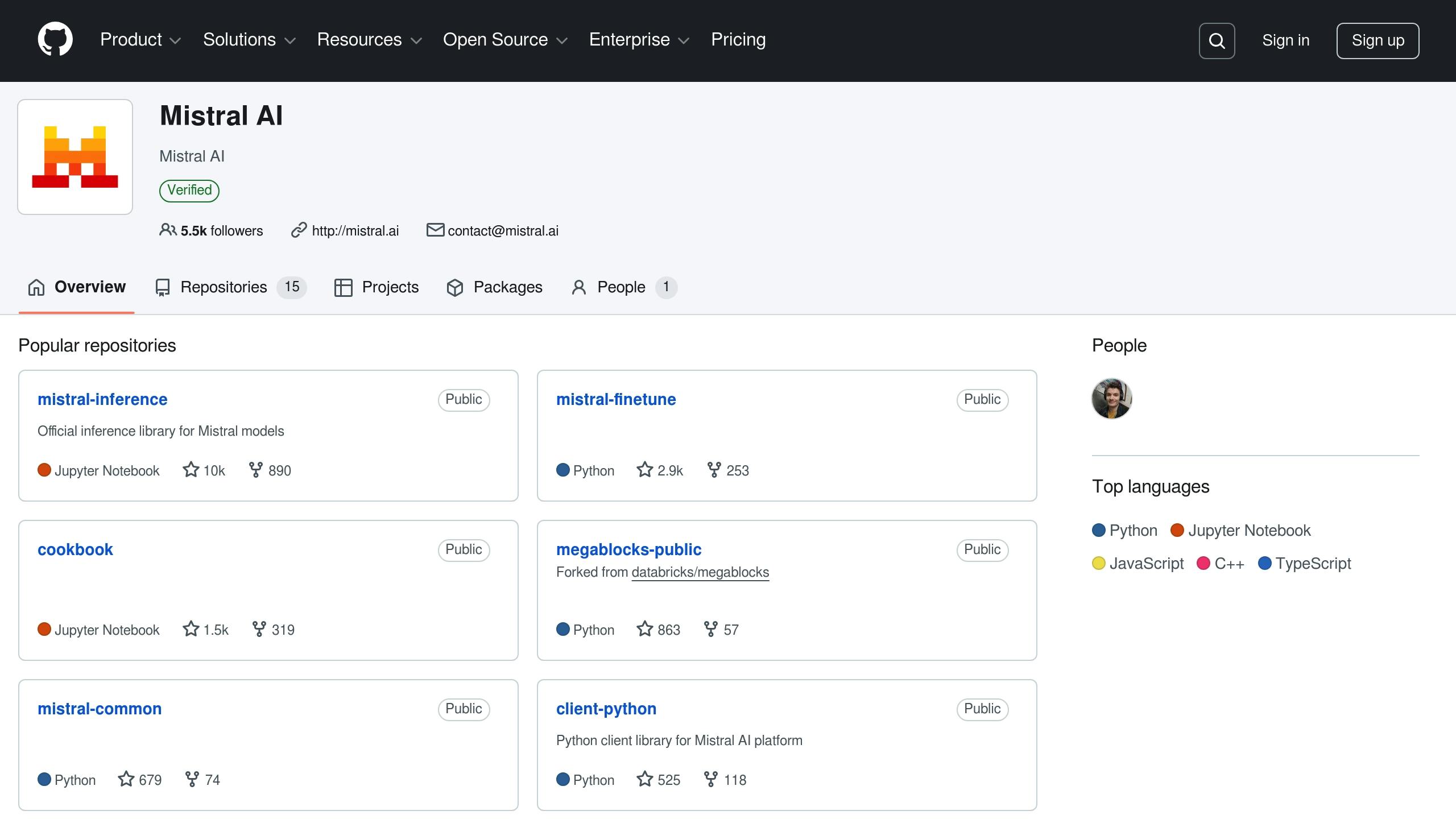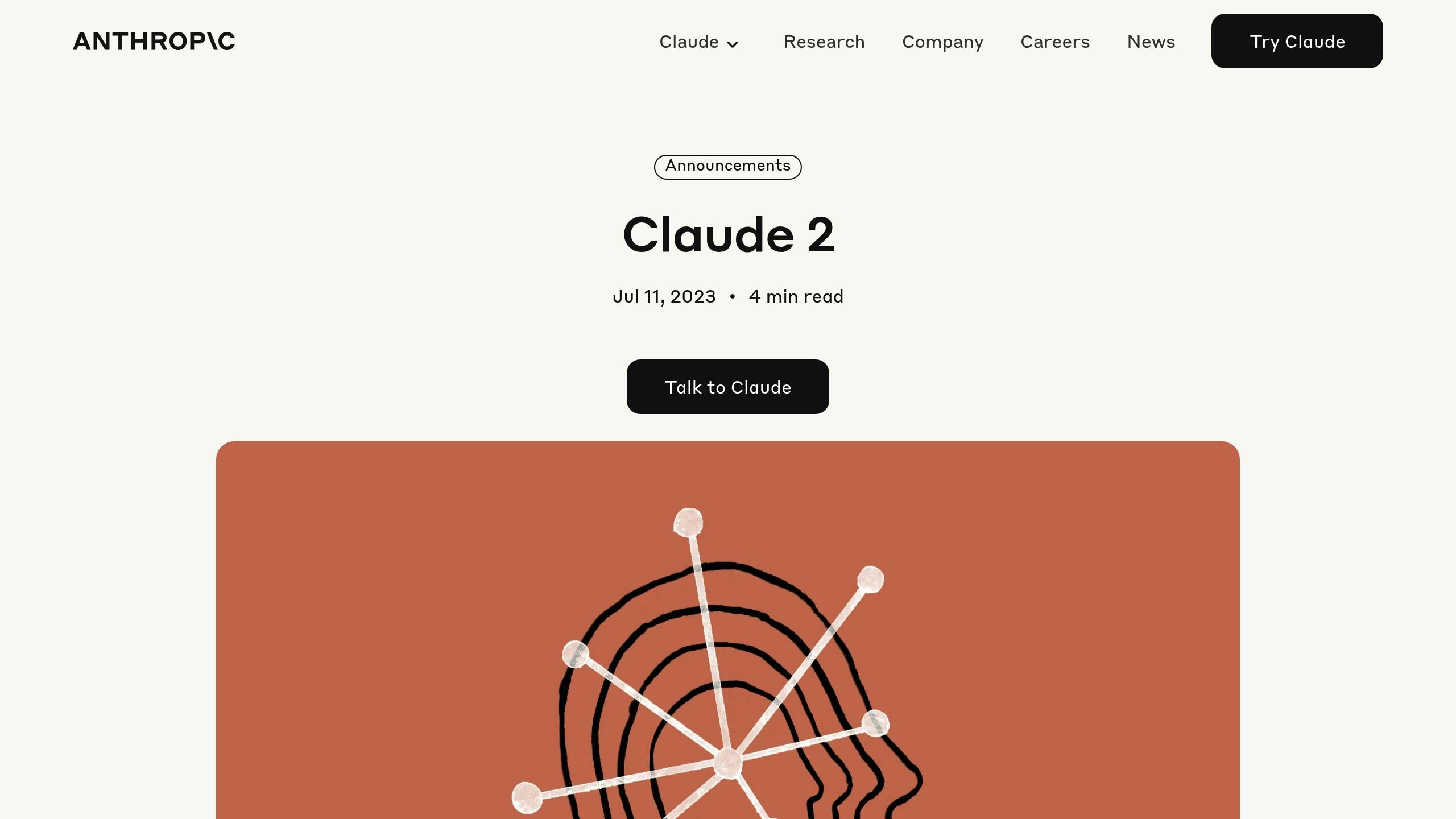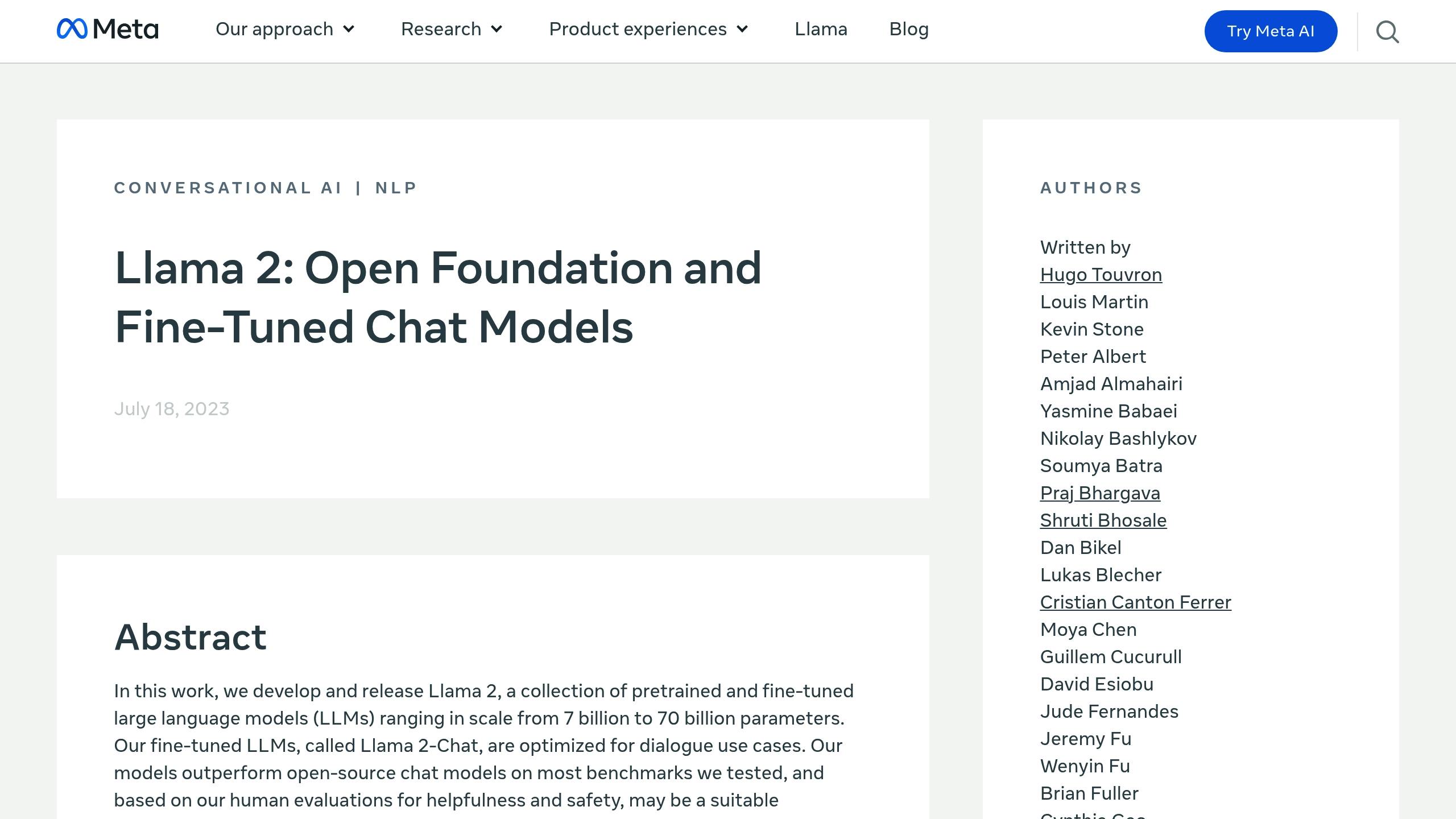Mistral-24B-Reasoning is a 24-billion-parameter open-source AI model designed for advanced reasoning tasks. It rivals larger proprietary models like GPT-4 and Claude 2 in performance while being more accessible and efficient. Here’s why it stands out:
- Performance: Achieves 81% accuracy on MMLU and outperforms GPT-4 in AIME scores (87.3% vs. 83.3%).
- Efficiency: Runs on consumer hardware (e.g., RTX 4090, MacBook with 32GB RAM) and generates tokens 3x faster than GPT-4.
- Features:
- 32k token context window for handling complex inputs.
- Apache 2.0 license for commercial use and customization.
- Specialized training for logic and reasoning tasks.
- Comparison:
- Matches or exceeds larger models like LLaMA 2-70B in reasoning benchmarks while being more hardware-friendly.
- Offers local deployment for privacy-sensitive applications, unlike cloud-only GPT-4.
Quick Comparison
| Model | Parameters | Context Length | Key Strengths | Deployment |
|---|---|---|---|---|
| Mistral-24B | 24B | 32k tokens | Advanced reasoning, cost-efficient | Local setup |
| GPT-4 | ~1.76T | 25k+ tokens | Multi-modal, high reasoning scores | Cloud-based |
| Claude 2 | Unknown | 100k tokens | Long context, reduced hallucination | Cloud-based |
| LLaMA 2-70B | 70B | 4k tokens | Fine-tuning, open-source flexibility | Multi-GPU |
Mistral-24B is a strong, open-source alternative for reasoning tasks, especially for those prioritizing cost, efficiency, and local deployment.
Mistral Large vs GPT4 – Practical Benchmarking
1. Mistral-24B Features

Mistral-24B stands out with a technical design that ensures efficient performance without compromising its capabilities. Its architecture integrates several advanced features:
| Feature | Specification | Impact |
|---|---|---|
| Model Architecture | 40-layer transformer with 5,120-dimensional embeddings | Handles complex reasoning tasks efficiently |
| Attention System | 32 attention heads, including 8 optimized heads | Enhances pattern recognition and contextual understanding |
| Tokenizer | Multilingual tokenizer with a 131k vocabulary | Accurately processes diverse languages and inputs |
These design elements contribute to its impressive benchmark results: 84.8% accuracy on HumanEval and 70.6% on mathematical reasoning tasks[3]. It even surpasses larger models in latency-sensitive scenarios, achieving higher AIME scores than GPT-4 (87.3% vs. 83.3%).
The model excels in several areas:
- Breaking down complex problems
- Identifying causal relationships in data[1]
- Applying knowledge across different domains
Its multilingual capabilities make it suitable for global use cases. Additionally, training on datasets like OpenR1-Math-220k and s1K-1.1[2] improves its mathematical and logical reasoning skills. This efficient architecture delivers commercial-grade performance in a user-friendly format.
2. GPT-4 Features
GPT-4 continues to lead the way in AI, offering advanced capabilities in both text and visual input processing. Its design supports complex reasoning tasks, making it a benchmark for performance in the industry. Mistral-24B, with its specialized architecture, aims to compete with these high standards.
| Feature Category | Capabilities | Performance Metrics |
|---|---|---|
| Reasoning & Problem-Solving | Handles complex instructions, Logical analysis | 90th percentile Bar Exam, 93rd percentile SAT[9] |
| Context Processing | Handles extended context windows | Processes 25k-word inputs[10] |
| Technical Performance | Code generation, Security awareness | 5% vulnerability rate in SQL injection tests[11] |
| Mathematical Ability | Advanced calculations, Symbolic reasoning | Achieves 90%+ accuracy in symbolic reasoning[8] |
The model excels in symbolic reasoning tasks with over 90% accuracy[8] and can process inputs as large as 25,000 words, thanks to its mixture-of-experts architecture.
GPT-4 also prioritizes content safety. It incorporates mechanisms to minimize bias and filter inappropriate content[7][11], all while maintaining high performance levels. This focus on safety is a distinguishing factor compared to Mistral’s open-source model, which is designed for developer customization.
For technical tasks, GPT-4 proves highly effective in code generation and analysis. It can write, debug, and optimize code across multiple programming languages[9], making it a valuable tool for software development. Its enhanced security measures are evident in its low vulnerability rate for generating SQL injection-prone code, outperforming earlier models[11]. While GPT-4 emphasizes proprietary safety features, Mistral’s open-source framework offers flexibility for developers to implement their own security measures.
3. Claude 2 Features

Claude 2 offers advanced abilities in reasoning and analysis, supported by its capacity to handle up to 100,000 tokens[12][16]. This makes it well-suited for tackling complex tasks that require deep understanding and extended context processing.
| Feature Category | Capabilities | Performance Metrics |
|---|---|---|
| Context Processing | Analyzes long documents, supports multiple formats | Handles up to 100,000 tokens[12][16] |
| Reasoning Skills | Excels in legal analysis, handles mathematical problems | Achieved 76.5% on the Bar exam[15] |
| Safety & Ethics | Uses constitutional AI, reduces bias | Cuts hallucination rate by 50%[14] |
| Technical Analysis | Debugs code, interprets data | Reaches 80% accuracy in human testing[12] |
Claude 2 minimizes hallucination rates by 50% through enhanced precision mechanisms[14]. Its use of constitutional AI ensures stricter safety measures compared to open-source models. For instance, while Mistral focuses on customization through open-source flexibility, Claude 2 prioritizes proprietary safety protocols.
The model also excels in technical tasks like code debugging and data analysis across various programming languages[13]. It can process diverse formats, including PDFs, Word documents, charts, and images[13], offering broader utility compared to Mistral-24B, which specializes in localized reasoning tasks.
A key distinction lies in ethical frameworks: Claude 2 enforces built-in safety measures, while Mistral-24B allows developers to tailor their own ethical guidelines. This difference is particularly important for enterprise users with specific compliance needs.
Claude 2’s performance on standardized tests highlights its strong legal reasoning and analytical skills, achieving results comparable to human expertise.
sbb-itb-5392f3d
4. LLaMA 2-70B Features

LLaMA 2-70B stands out in the open-source AI space with its 70 billion parameters and a 4,096-token context window[17]. It uses an attention system designed to improve inference speed without sacrificing performance[19]. While its parameter count suggests a larger capacity for handling complex tasks, Mistral-24B, with only 24 billion parameters, achieves similar reasoning capabilities at just 35% of the size.
| Feature | Specification | Performance Impact |
|---|---|---|
| Parameters | 70 billion | Improved reasoning and analytical capabilities |
| Context Length | 4,096 tokens[19] | Shorter than Mistral’s 32k tokens, limiting certain tasks |
Deploying LLaMA 2-70B comes with challenges. Its size demands multiple high-end GPUs, as single GPUs like the NVIDIA A10 (24GB) or A100 (40GB) lack the memory to handle it[17]. This makes resource planning and deployment more complex for organizations.
One of the model’s standout features is its fine-tuning capability[18], allowing it to be tailored for specific industries or tasks while retaining its core reasoning strength. This makes it a flexible option for businesses needing specialized solutions.
Key technical improvements further enhance its performance:
- A 32K-token vocabulary boosts efficiency by 15%, alongside better memory management[19].
- Continuous batching improves throughput, enabling smoother operations[17].
While LLaMA 2-70B pushes the boundaries of open-source AI with its scale and customization options, Mistral-24B offers a leaner, more hardware-friendly alternative. For organizations needing advanced reasoning and the ability to fine-tune, LLaMA 2-70B remains a compelling choice.
Performance Overview
Mistral-24B stands out by delivering strong results with fewer computational resources, surpassing larger models in several key benchmarks:
| Model | MTBench | WildBench | Arena Hard | IFEval | Parameter Count |
|---|---|---|---|---|---|
| Mistral-24B | 8.35 | 52.27 | 0.873 | 0.829 | 24B |
| Gemma-27B | 7.86 | 48.21 | 0.788 | 0.807 | 27B |
| Qwen-32B | 8.26 | 52.73 | 0.860 | 0.840 | 32B |
| LLaMA-70B | 7.96 | 50.04 | 0.840 | 0.884 | 70B |
| GPT4o-mini | 8.33 | 56.13 | 0.897 | 0.850 | ~1.76T |
These results highlight Mistral-24B’s ability to rival models up to three times its size, all while maintaining a token generation speed of 150 tokens per second[4].
Human Evaluation Insights
Human assessments further validate Mistral-24B’s strengths:
- Beats Gemma-27B: Preferred 73.2% of the time.
- Outperforms Qwen-32B: Chosen 68% of the time.
- Holds its ground against LLaMA-70B: Achieves a 35.6% win rate.
Key Features and Strengths
Mistral-24B achieves its high performance without relying on reinforcement learning or synthetic data[4]. It excels particularly in mathematical reasoning, reinforcing its reputation as a robust option.
With these benchmarks, Mistral-24B positions itself as a highly efficient open-source alternative to proprietary models like GPT-4, while outperforming larger open-source models such as LLaMA-70B.
Key Findings
Mistral-24B stands out with measurable advancements in three main areas, building on the technical strengths previously discussed.
Reasoning Capabilities and Performance
Mistral-24B delivers strong results in reasoning tasks, achieving 81% accuracy on MMLU[21] and 85.6% accuracy on ARC-Challenge[20]. These scores highlight its ability to handle complex tasks effectively, reflecting the benchmark dominance noted earlier.
Practical Applications and Use Cases
Mistral-24B proves useful in several scenarios:
- Enterprise Development: Provides a cost-efficient alternative to proprietary models, allowing secure local processing of sensitive data[3].
- Resource-Optimized Deployment: Performs well on consumer-grade hardware, making it an accessible option for smaller organizations[21].
Technical Advantages
The streamlined design of the model brings notable benefits:
| Aspect | Benefit |
|---|---|
| Language Support | Handles multiple languages[6][5] |
Development Considerations
Key implementation benefits include maintaining control over local data, lowering computational expenses, and supporting community-driven customization[6][5]. These features make Mistral-24B a practical open-source tool for advanced reasoning tasks.
FAQs
Is Mistral better than ChatGPT 4?
Here’s a detailed comparison based on practical implementation factors:
| Aspect | Mistral-24B | GPT-4 |
|---|---|---|
| Deployment | Local setup with an RTX 4090 or a 32GB RAM MacBook | Cloud-based only |
| Cost Efficiency | Flexible open-source deployment | Higher operational expenses |
| Performance | Scores 84.8% on multi-domain reasoning tasks (Bar Exam[3]) | Scores in the 90th percentile on Bar Exam[9] |
| Privacy | Processes data locally, avoiding third-party exposure | Requires API-based data processing |
| Customization | Full access to the model’s architecture | Limited to API-level adjustments |
Key differences:
- Mistral-24B: Known for its hardware efficiency, running up to 3x faster, and its ability to be deployed locally, making it ideal for privacy-sensitive needs.
- GPT-4: Excels in multi-modal tasks and can handle extreme-scale reasoning with a 128k context window.
Mistral-24B stands out as a highly efficient open-source reasoning model, especially for those prioritizing cost and privacy. Meanwhile, GPT-4 shines in versatility and advanced reasoning capabilities.

